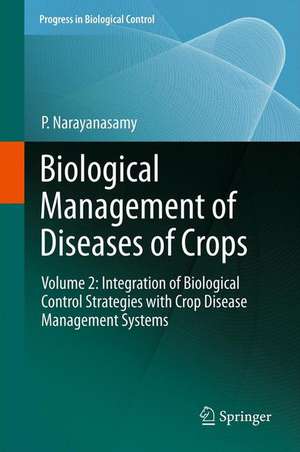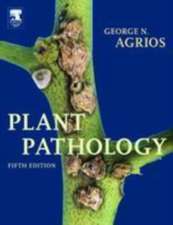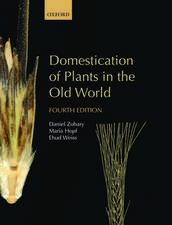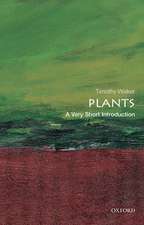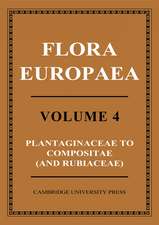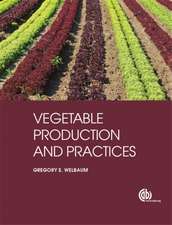Biological Management of Diseases of Crops: Volume 2: Integration of Biological Control Strategies with Crop Disease Management Systems: Progress in Biological Control, cartea 16
Autor P. Narayanasamyen Limba Engleză Hardback – 19 iun 2013
| Toate formatele și edițiile | Preț | Express |
|---|---|---|
| Paperback (2) | 1043.81 lei 38-44 zile | |
| SPRINGER NETHERLANDS – 15 iul 2015 | 1043.81 lei 38-44 zile | |
| SPRINGER NETHERLANDS – 15 iul 2015 | 1219.58 lei 38-44 zile | |
| Hardback (2) | 1054.23 lei 38-44 zile | |
| SPRINGER NETHERLANDS – 19 iun 2013 | 1054.23 lei 38-44 zile | |
| SPRINGER NETHERLANDS – 10 iul 2013 | 1230.54 lei 38-44 zile |
Din seria Progress in Biological Control
- 18%
 Preț: 952.57 lei
Preț: 952.57 lei - 18%
 Preț: 1222.01 lei
Preț: 1222.01 lei - 18%
 Preț: 1381.58 lei
Preț: 1381.58 lei - 18%
 Preț: 955.25 lei
Preț: 955.25 lei - 18%
 Preț: 956.33 lei
Preț: 956.33 lei - 15%
 Preț: 632.19 lei
Preț: 632.19 lei - 15%
 Preț: 657.25 lei
Preț: 657.25 lei - 15%
 Preț: 649.06 lei
Preț: 649.06 lei - 18%
 Preț: 1412.20 lei
Preț: 1412.20 lei - 18%
 Preț: 942.76 lei
Preț: 942.76 lei - 24%
 Preț: 797.39 lei
Preț: 797.39 lei - 18%
 Preț: 1117.03 lei
Preț: 1117.03 lei - 18%
 Preț: 948.16 lei
Preț: 948.16 lei - 15%
 Preț: 652.17 lei
Preț: 652.17 lei - 15%
 Preț: 653.14 lei
Preț: 653.14 lei - 18%
 Preț: 956.81 lei
Preț: 956.81 lei - 18%
 Preț: 1234.77 lei
Preț: 1234.77 lei - 18%
 Preț: 936.29 lei
Preț: 936.29 lei - 18%
 Preț: 1225.94 lei
Preț: 1225.94 lei
Preț: 1054.23 lei
Preț vechi: 1387.14 lei
-24% Nou
Puncte Express: 1581
Preț estimativ în valută:
201.75€ • 219.07$ • 169.47£
201.75€ • 219.07$ • 169.47£
Carte tipărită la comandă
Livrare economică 18-24 aprilie
Preluare comenzi: 021 569.72.76
Specificații
ISBN-13: 9789400763760
ISBN-10: 940076376X
Pagini: 388
Ilustrații: XXII, 364 p.
Dimensiuni: 155 x 235 x 27 mm
Greutate: 0.72 kg
Ediția:2013
Editura: SPRINGER NETHERLANDS
Colecția Springer
Seria Progress in Biological Control
Locul publicării:Dordrecht, Netherlands
ISBN-10: 940076376X
Pagini: 388
Ilustrații: XXII, 364 p.
Dimensiuni: 155 x 235 x 27 mm
Greutate: 0.72 kg
Ediția:2013
Editura: SPRINGER NETHERLANDS
Colecția Springer
Seria Progress in Biological Control
Locul publicării:Dordrecht, Netherlands
Public țintă
ResearchCuprins
Preface.- Acknowledgement.- 1. Introduction.- 2. Cultural practices influencing biological management of crop diseases.- 3. Physical techniques for biological crop disease management.- 4. Biological control of microbial plant pathogens in alternative sources of infection.- 5. Development of formulations and commercialization of biological products.- 6. Biological disease management systems for agricultural crops.- 7. Biological disease management systems for horticultural crops.
Recenzii
From the reviews:
“Narayanasamy provides a comprehensive discussion of the importance of biological management of plant pathogens in order to feed an ever-expanding population. … Volume 2, Integration of Biological Control Strategies with Crop Disease Management Systems, contains seven chapters covering both cultural and physical methods related to biological management, developing and commercializing BCAs, and biological management in agriculture and horticulture. … Summing Up: Highly recommended. Graduate students, researchers/faculty, and professionals/practitioners.” (R. Frederiksen, Choice, Vol. 51 (7), March, 2014)
“Narayanasamy provides a comprehensive discussion of the importance of biological management of plant pathogens in order to feed an ever-expanding population. … Volume 2, Integration of Biological Control Strategies with Crop Disease Management Systems, contains seven chapters covering both cultural and physical methods related to biological management, developing and commercializing BCAs, and biological management in agriculture and horticulture. … Summing Up: Highly recommended. Graduate students, researchers/faculty, and professionals/practitioners.” (R. Frederiksen, Choice, Vol. 51 (7), March, 2014)
Textul de pe ultima copertă
Effectiveness of biological management of diseases may depend on the nature of interactions between the pathogens and other organisms and the plants. Because of development of resistance in pathogens to fungicides and bactericides, selection of strains of biocontrol agents (BCAs) showing resistance to synthetic chemicals is essential to to restrict use of the chemicals. Microbial plant pathogens and the antagonists present in the soil and on the plant surfaces are influenced by the cultural practices such as ploughing, nutrients applied, date of planting and harvesting, plant spacing, irrigation and harvest operations. Crop sanitation is a simple and important practice to eliminate or reduce the pathogen inoculum. It is possible to reduce disease incidence and intensity by including appropriate rotational crops which are resistant/immune to the target pathogen. Intercropping has been shown to be effective in reducing the incidence of virus diseases. Application of physical and chemical techniques involving the use of heat, solarization and irradiation may reduce the pathogen population or weaken potential of pathogens present in seeds, plants and soil. Irradiation with UV-C has favorable effect on fruits and vegetables which exhibit resistance to postharvest pathogens. Seed treatment with UV-C reduces infection by seedborne pathogens too. Some of the fungal pathogens have been identified as mycoherbicides. Entomopathogenic fungi effective against important groups of insects functioning as vectors of viruses have been identified. Two types of formulations are made from microbial antagonists. Liquid formulations as flowable or aqueous suspensions in water, oils or emulsions are prepared. Dry formulation products are available as wettable powders, dusts or granules. The bioproducts are applied to soil, seeds, propagative plant materials, whole plants and harvested produce as protective or curativetreatments. Biological disease management systems for agricultural and horticultural crops have been developed by integrating strategies with synergistic effects on each other. Efforts to develop integrated systems of disease management have been scarce. Methods of integrating management strategies for diseases affecting agricultural and horticultural crops and the achievement of high levels of disease control are discussed. Protocols for isolation/ identification and assessing the biocontrol activities of biotic and abiotic biocontrol agents provided in relevant chapters will be useful for researchers and teachers.
Caracteristici
Discussion on the biological activities of both biotic and abiotic bioagents under natural field conditions is presented with several illustrations only in this book, providing a significant benefit and opportunity to the audience to have complete information from a single source Information on the biological management of postharvest diseases, weeds and vectors of diseases that form additional sources of inoculum and various procedures followed for formulation and commercialization of bioproducts is included in this book to provide additional advantage to the audience Presentation of case studies of integrating different biological control strategies compatible with crop production systems for the effective management of diseases caused by microbial pathogens is yet another attempt to make the book to be more useful to the readers who cannot find this aspect in any other book
